Talk with our local travel specialist who can help organize your trip.
10 UNESCO World Heritage Sites in Nepal
Situated in the Himalayas center, the landlocked country of Nepal is home to a treasure of UNESCO World Heritage Sites. From wild forests to ancient cultures, Nepal has a perfect blend of culture, history, and nature; suitable for travelers' well-seasoned.
The United Nations Education, Scientific and Cultural Organization (UNESCO) has listed ten sites in Nepal. Sites like Kathmandu Durbar Square, Bhaktapur Durbar Square, Patan Durbar Square, Swayambhunath, Pashupatinath, Boudhanath, Changunarayan, Lumbini, Chitwan National Park, and Sagarmatha National Park are listed as the world heritage sites of Nepal. Among them, eight are cultural and the other two are natural attractions that have their characteristics and attractions. These features offer various information, entertainment, education and adventure in its ways. The heritages have their ancient history and cultural significance that goes back to a few centuries. Also, natural sites are full of vegetation, wildlife, and diverse landscape.
Here, we bring out to the 10 UNESCO World Heritage sites of Nepal along with their facts and information for you to get an insight about them.
Table of Content
1. Kathmandu Durbar Square

Kathmandu Durbar Square was listed as UNESCO World Heritage Site in 1979. Situated in Kathmandu, Kathmandu Durbar Square has Hanuman Dhoka, Panch Mukhi Hanuman Temple, Mul Chowk, Mohan Chowk, Sundari Chowk, Tribhuvan Museum, King Mahendra Memorial Museum Degutale Temple, Taleju Mandir, Nasal Chowk, Nine story Basantapur Tower, and Kal Bhairab temple in its area. Kathmandu Durbar Square is famously known as Basantapur Durbar Square, Freak Street. This is one of the main highlights in Kathmandu Valley. This palace has a huge Royal Square impressive several temples devoted to different Hindu gods and goddesses. Most of the structures we see here are built between 15th to the 18th century.
You can explore Kumari Ghar, the house of the living goddess of Nepal, Kumari. This was erected in 1757 by Jaya Prakash Malla. Kumari is a young girl chosen to be the living goddess until she hits her first puberty and relapses to being a normal mortal. Kasthamandap, the house of wood, is thought to be built from a Single Sal tree. At the start, it used to be a community hall where local people assembled for vital ceremonies and later, it was made Temple of Gorakhnath.
Facts about Kathmandu Durbar Square
- Kasthamandap is translated as “Kathmandu” in Nepali.
- Considered the oldest building in Kathmandu Valley, the Kasthamandap temple was erected in the far 12th century with all wood from one single tree.
- Hanuman Dhoka in eastern Durbar Square is the biggest existing historical place with the most plentiful art collection in Nepal.
- Statues of hanuman stand on the stone pier of the left palace gate, enclosed with a red brocade canopy.
- Built-in 1549, Taleju Temple, a three-storeyed gold-plating eave Tempio, is the tallest temple in Kathmandu with a height of about 35m.
- Kaal Bhairab is a huge stone statue of Bhairab (Lord of Terror), one of Shiva's rebirths in northern side of Durbar Square.
- The legend has it that if any individual can interpret the 17th-century inscriptions written in 15 languages on the Hanuman Dhoka wall, there would be immediate flooding of milk from the wall. Hanuman Dhoka is the former palace of Malla and Shah Kings.
- The palace has 17th-century monuments of Hanuman and Lord Narasimha.
- The palace is an architecture that depicts culture, religion, history, custom, and tradition.
- The Square is full of life itself where you can see vendors sell stuff from vegetables to unique crafts around the rest house. The rest house is built with the wood of a single tree from which Kathmandu got its name initially.
- Kathmandu Durbar Square is a tourist hub and the sights of statues, woodcraft and architecture are stunning.
2. Bhaktapur Durbar Square

Bhaktapur is on the east of Kathmandu valley which was listed as a UNESCO World Heritage Site in 1979. It is also known as Bhadgaon or Khwopa, Bhaktapur is considered as the home to ancient Nepali customs, culture, art, and history.
The major highlights of the square are 55 Window Palace. This is the main architectural building of the square built in the 15th century. Golden Gate is the main entry point to the palace. You will explore amazing artistry on the gate. Lions Gate where you will see two pleasing stone statues of Hindu deities installed on both sides. There is a story that believes the hands of artists who made this were cut off right now. Another well-known temple is Nyatapola Temple, which is a renowned pagoda of Nepal. This is the highest pagoda of Nepal ever built with architectural excellence and artistic exquisiteness. This temple is dedicated to Siddhi Laxmi, the tantric goddess of ultimate power and success.
Facts about Bhaktapur Durbar Square
- Each ancient monument offers the medieval culture, religion, tradition, and customs of Nepal.
- Bhaktapur is home to local Newari people and has remained untouched by modernity. Lion Gate, Nyatapola Temple Golden Gate, Art Gallery, Statue of King Bhupatindra and fifty-five windowed Malla Palace are Bhaktapur's living significance.
- Bhaktapur is the city of Devotees and is popular for its unique art, culture, festival, dance, and typical Newari lifestyle.
- Local dance and festivals are witnessed by the locals and relish their ancestors' same enthusiasm in the past.
- The Hindus and Buddhists have coexisted in peace through the ages. Bhaktapur is mainly comprised of the masonry, peasantry, painting, carving, bronze casting, jewelry; pottery, etc are other traditional originalities still prevailing.
- Monuments and artistic statues on wood, stone, and metals are sprinkled all over the city's historical hub.
- Lanes and narrow and zigzagged alleys take you to see the Environment of Newar primitive settlements.
3. Patan Durbar Square

Situated 5kms South East of Kathmandu valley, Patan is enclosed by 4 stupas erected by Emperor Ashoka in 3rd century BC. Patan is also known as Lalitpur and was listed as a UNESCO World Heritage site in 1979. Patan is the ancient Buddhist City in the world.
Patan is well known for its artistic culture, and there are 4 stupas at every corner of the city. Patan Durbar Square has three main courtyards, Mul Chowk, Sundari Chowk, and Keshav Narayan Chowk. You can explore a masterpiece of stone design, the Royal bath called Tushahity in the focus of Sundari Chowk. The major highlights inside the Patan Durbar Square are- the Patan Museum that includes bronze sculptures and religious entities. This museum is regarded as one of the best museums in Asia. Hiranya Varna Mahavihar is a three-story golden pagoda of Lokeshwar (Lord Buddha), erected in the 12th century by King Bhaskar Verma. Mahaboudha Temple is a Shikhar Style temple is devoted to the Lord Buddha. This temple has five golden pinnacles. The Golden Temple is the ancient and culturally richest temple of Buddha. This temple was erected in the 12th century known for its gorgeous gold works. Krishna Temple is built in the 17th century and is the main temple of this Square that has 21 shrines and is entirely made of stone.
Facts about Patan Durbar Square
- It is believed that in the historic time Kathmandu was immersed in extreme drought and three people were assigned to summon God Red Machhendranath into the valley for rainfalls.
- Patan is also known as Yala because of King Yalamber. As per history, Patan was found in the 3rd century by the Kirats and remodeled by Lichhavis followed by Mallas.
- Patan Durbar Square, Mulchowk, Jagat Narayan Temple, Big Bell, Pillar of Yognarendra Malla, Hari Shanker temple, Vishwanath temple, Bhimsen temple, Mahaboudha Temple, Kumbeshwor temple, Krishna Temple, Golden Temple of Hiranya Varna Mahavihar, Marga Hiti, Mani Mandap, Café Pagoda, Minnath, Rudra Varna Mahavihar, Rato Machhendra Temple, etc are the major highlights of Patan.
- Krishna temple is the most vital temple in Patan Durbar Square with 21 golden pinnacles in the temple.
- Vishwanath Temple is devoted to God Shiva which was built in 1627 during the rule of Siddhi Narsingh Malla.
- The three major yards in the palace are Sundari Chowk, Mul Chowk and Keshav Narayan Chowk.
Featured Trips
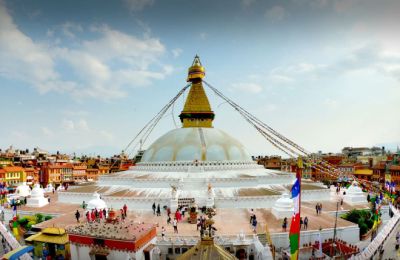
Kathmandu Heritage Tour - 1 day
Kathmandu Heritage Tour lets you explore the city’s iconic UNESCO World Heritage Sites. Walk through the medieval city and discover Kathmandu’s cultural gems.
Inquire Now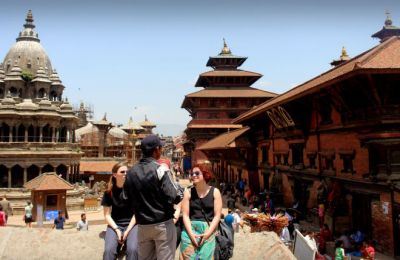
Kathmandu Ancient City Tour - 1 day
Our Kathmandu Ancient City Tour package includes full sightseeing of the medieval cities of Patan and Bhaktapur and the ancient Hindu temple of Changu Narayan. The sites that you will visit are listed in the UNESCO World Heritage Sites.
Inquire Now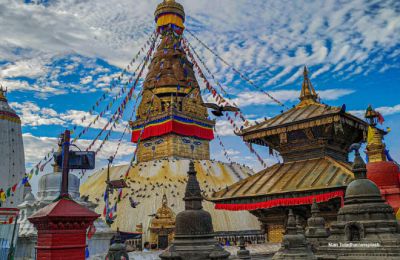
Kathmandu UNESCO World Heritage Sites Tour - 1 day
Kathmandu UNESCO World Heritage Sites Tour takes you to 4 major tourist attractions and UNESCO World Heritage Sites in Kathmandu city: Pashupatinath , Kathmandu Durbar Square, Boudhanath and Swayambhunath.
Inquire NowWhere to travel next?
Get help from our travel specialists for holiday ideas that matches your interests.
4. Swayambhunath (Monkey Temple)

Swayambhunath, listed as UNESCO World Heritage Site in 1979, is a Buddhist stupa located 3kms away from the west of Kathmandu. The hilltop view offers a panoramic view of the valley and the landscape around it. It is a pilgrimage site for the Buddhists and offers cultural and natural beauty from the stupa itself.
Swayambhu means "self-existent one". Assumed to date back to 460 A.D., it was erected by King Manadeva and by the 13th century, it had become a vital hub of Buddhism. It is believed that Swayambhu was born out of a lotus flower that blossomed in the center of a lake that once spread across the Kathmandu Valley once was. The biggest image of the Sakyamuni Buddha in Nepal is on a high base on the western boundary of Swayambhu beside the Ring Road. Behind the hilltop is a temple devoted to Manjusri or Saraswati - the Goddess of learning. Prayer wheels and deities enclose the base of the hill.
Facts about Swayambhunath
- It is believed that Swayambhunath was an island thousands of years back. Later, a stupa was built by King Manadeva in 460.
- The stupa is a solid hemisphere of brick and clay with a conical spire capped by a copper gilt pinnacle.
- Lord Buddha's eyes are fixated on all four sides of the spire base.
- It serves as the nerve center of respect and faithfulness for all the devout philosophies of Bajrayan and Lord Adi Buddha.
- It is devoted to the self-originating God of flame.
- The 4 pairs of eyes of Lord Buddha depict that the god has an eternal watch on the valley and is looking after its people.
- Situated on the top of the hill, it is 500ft above valley level.
- You can explore small Chaityas and pagoda temples with great five Mahayana (Lamaism) and Hinayana (Therbadist).
5. Pashupatinath

Pashupatinath, listed as UNESCO World Heritage Site in 1979, is the holy pilgrimage site for the Hindus and is a temple of Lord Shiva. The temple lies along the banks of the sacred Bagmati River, 5kms east of Kathmandu city. Pashupatinath goes from the main temple of Pashupatinath to Guheswori. There are various temples inside this area including the Panchdewal Bhuwaneshwori, the Dakshinamurti, Tamreshwor, Bishwarupa, and others. The temple of Kali, situated on River Bagmati banks, has a stimulating appearance and loaded with mythology. The legend says that the statue grows out of its unique spot. Each temple has its own set of rites to be achieved, and every temple has specific values and traditions. On the other side of the river is a small jungle Shleshmantak, homes to animals like deer and monkeys.
Facts about Pashupatinath
- It is a two-tiered roof and four silver doors. Bagmati River is a holy river where people come to perform different rituals.
- Pashupatinath Temple is the main holy site on Shivaratri's day, where devotees come from different places.
- The temple is famous for its big Maha Shivaratri festival in spring that attracts hundreds of thousands of devotees from within Nepal and from India.
- Further east before the Bagmati touches Pashupati is the temple of Guheshwori.
- Built in the 5th century and later renewed by Malla kings, the area has existed from the beginning of the time when a Shiva lingam was found here.
- The largest temple in Nepal goes on both sides of the Bagmati River which is regarded holy by Hindus.
- The main pagoda-style temple has a golden roof, four sides covered in silver, and beautiful wood carvings.
- Temples devoted to several other Hindu and Buddhist gods surround the temple of Pashupatinath.
- Only Hindus are allowed to enter the temple, and alien tourists can view the temple from Bagmati River's east side.
- Cremation of Hindus takes place on different platforms along the Bagmati River.
- It is believed that the temple devoted to Shiva was at the site in AD 879.
- A gold-plated rooftop, silver door and woodcarvings are the major highlight in the temple.
6. Boudhanath

Boudhanath, listed as UNESCO World Heritage Site in 1979, reflects the culture, tradition and pride of Tibetan Buddhism. The stupa is 8kms east of Kathmandu and was erected by Licchavis King Man Dev in 5th century AD. It is named as Khāsti in Nepal Bhasa, Jyarung Khashor in Tibetan language or as Bauddha in Nepali.
Stupas are vital to Buddhism as the cross is to Christianity, a concrete symbol of the Buddha’s liberal mind. The first stupa erected after 600 AD, after the Tibetan King Songtsen Gampo, was rehabilitated to Buddhism by his two wives. The current stupa structure was possibly built after the destruction of the Mughal invaders in the 14th century. After the entrance of thousands of Tibetans subsequent to the 1959 Chinese invasion, the temple has become one of the most vital centers of Tibetan Buddhism.
The arrival of large inhabitants of refugees from Tibet has seen the construction of over 50 Tibetan Gompas (Monasteries) around Boudhanath.
Facts about Boudhanath
- It is the biggest stupa and built on an octagonal base with alcoves. The stupa is enclosed with various temples or gompas.
- The stupa's ambiance is filled with zest as you can smell the fragrance of incense drifts in the air.
- Witness the chanting and prayer of monks and spin the prayer wheels while you stroll around the area.
- The four pairs of Buddha’s eyes offer a clear flash to the four cardinal directions which means that Lord Buddha is keeping a watch over the devotees all the time.
- The chhorten reflects Mahayana's philosophy, which is named Lamaism in Tibet, Bhutan, Sikkim and Ladakh.
7. Changunarayan

Changunarayan is a two-tiered Lord Vishnu temple, situated 15kms away from Kathmandu. It was listed in UNESCO World Heritage Site in 1979. The Changu Narayan temple is a double-roofed shrine devoted to Lord Vishnu in his manifestation as Narayan. The temple is adorned with ten incarnations of the Narayan. Stone lions guard all the four doors of the temple. Garuda, half-man and half-bird is the vehicle of the Vishnu. A life size stone statue of Garuda kneels in front of the west face of the temple. There is an engraving stone behind the statue. This provides important data on the Licahhavi dynasty and on the history of Kathmandu valley. In front of the temple’s main entrance, there are lesser statues of King Bhupatindra Malla and his queen in an ornate cage. To the north of the temple is the figurine of Vishnu seated on a Garuda. The sculpture dates back to the 9th century and is yet another attraction in the area.
Facts about Changunarayan
- You can find the stone inscription dating back to 464 AD and other pieces in the temple which reflects the ancient history of Nepal.
- The temple holds the sculptures of Vishnu’s ten incarnations; Nar-Singha Vishnu, Vishwaroop, Vishnu Vikranta, Vishnu riding Garuda, Chinnamasta Devi, Temples of Kileswar Shiva, along with other gods and goddesses.
- The temple offers a stunning view of the Manohara River flowing through lush vegetation.
- The temple is located 12 km east of Kathmandu and the Manohara River flows along the hill.
- The major shrine is thought to have been recognized in 325 AD, the temple was rebuilt in 1702 Ad after a devastating fire.
- The premises of Changu Narayan are also abode to one of the ancient stone slab which goes the 5th century and has various engravings from the Lichhavi Era.
- The temple is a superb piece of Nepali architecture with rich stamped works of wood and bronze.
- The temple has four entries and the gates are protected by life-size pair of animals such as Griffis lions, sarabhas and elephants on each side of the entrance.
- The struts of the temple feature the ten manifestations of Lord Vishnu and other idols carved in wood.
- The temple glows up during festivals such as the Mahashanan, Changu Narayan Jatra, Haribodhimi Ekadashi, and Nag Panchami.
Featured Trips
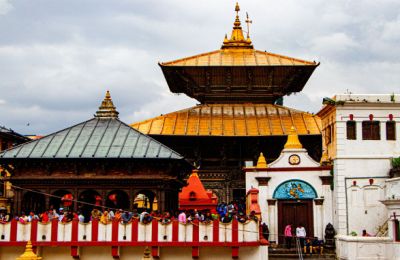
Kathmandu and Chitwan Tour - 6 days
Kathmandu and Chitwan Tour is an ideal package that allows you to experience Kathmandu and Chitwan National Park while enjoying history, nature, culture, and wildlife activities in the short 6 days
Inquire Now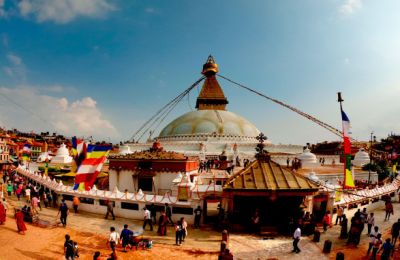
Explore Six UNESCO heritage sites and Nagarkot Sunrise - 3 days
Explore 6 of the UNESCO world heritage sites in Kathmandu Valley and embrace the sunrise over mountains, including the mighty Everest, from the Nagarkot viewpoint.
Inquire Now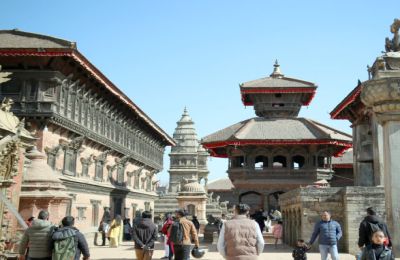
Patan and Bhaktapur Heritage Tour - 1 day
Visit the oldest and most beautiful cities in Nepal with this Patan and Bhaktapur Heritage Tour! Explore pristine temples, ancient architecture, stunning palaces and more.
Inquire NowWhere to travel next?
Get help from our travel specialists for holiday ideas that matches your interests.
8. Lumbini, The Birthplace Of Gautam Buddha

Lumbini is located in the southern Terai plains of Nepal and is southwest of Kathmandu. It is the birthplace of the light of Asia, Lord Gautam Buddha. In 1997, Lumbini was named in the list of world heritage sites. Based on the Buddhism tradition and scripture, he was born when his mother maya devi was on her way to parents’ home in Devdahain the month of May in 642 BC. After feeling the extrema labour pains, she grabbed hold the shade tree on the way and gave birth to Siddhartha Gautama who was enlightened as the future Buddha.
It was strong belief that Buddha was the final rebirth of his incarnation in this world. The Buddhist tradition also says that he walked immediately after getting birth. The beliefs say that he steeped seven steps just after his birth and considered to be the incarnation of God. In 249 BC, the great Ashoka who was considered to most powerful emperor of that era constructed stupas and a stone pillar which is known as Ashoka’s pillar in Lumbini.
Recommended Read: Getting From Kathmandu To Lumbini
Facts about Lumbini
- The holy pilgrimage site for Buddhist attracts many tourists from all over the world. Emperor Ashoka in 250 BC made a large stone pillar with an inscription about the birth of Buddha.
- Lumbini holds historical, cultural and religious importance.
- You can explore the popular destinations such as Lumbini Garden, China Temple, Thai Monastery, World Peace Pagoda, Nepal Buddha Temple, Burmese (Myanmar) Temple, Maya Devi Temple, Tara Foundation, and Dharmaswami Buddhist monastery.
- In 1st December 1896, Lumbini was rediscovered by Dr. Fuhrer (German) and Khadga Shumsher Rana.
- They mined the Lumbini mound and found the Asoka Pillar and explored the famous inscription stating the Birthplace of the Sakyamuni Buddha in Lumbini.
- In 1933-39, General Kesher Shumsher performed a major mine at Lumbini.
- He showed buildings by unscientific methods that caused great damage to the site.
- He engorged the Sakya pool with a sequence of steps and a brick perimeter.
9. Chitwan National Park

Chitwan National Park has an area of 932 sq kilometers and is situated in the inner belt of Chitwan. The word ‘Chitwan’ is translated as ‘Heart of the Jungle.’ In 1984, Chitwan was listed in the UNESCO World Heritage Site. Chitwan National Park is a 360 square mile park situated in Nepal. From the late 1800s to the mid-1900s the region now elected Chitwan National Park was used for the hunting ground of the ruling class in Nepal.
It was so hard to reach it was a trip on foot that was numerous weeks long. In the 1950s when the settlement of the area began, stealing became an issue. Wildlife laws began to be applied. By the late 1960s, most of the jungles had been devastated and rhinos were almost extinguished. In 1973 Chitwan National Park was made with 210 square miles of conserved area. It was stretched to 360 square miles in 1977.
Facts about Chitwan National Park
- The park is known for the stunning excursion through the jungle safari. With nature at its peak, you will encounter the rarest species of the ecosystem.
- Enjoy the canoeing through the lake in the park with crocodiles which add more adventure to your trip.
- One Horned Rhinoceros, Gharials, Royal Bengal Tiger, clouded leopard, and rock python are some rarest animals protected in the park.
- Bengal florican lesser florican, redhead florican, etc are some endangered birds are also seen in the park.
- Chitwan National Park is regarded as one of Asia’s best national parks for exploring wildlife.
- Chitwan National Park exists within a high humidity area that experiences a tropical monsoon climate. The monsoon season goes from the middle of June until the end of September.
- There are at least 68 species of mammal found within Chitwan including the Bengal tiger, leopards, Asian palm civets, rhinos, elephants, guars, wild boars, hog deer, sambar deer, rhesus monkeys, flying squirrels, antelopes, tallow-throated martens, mongooses, sloth bears, smooth-coated otters, Bengal foxes, honey badgers, spotted linsangs, striped hyenas, golden jackals, jungle cats, fishing cats and the rare hispid hare species.
- All in all, the whole park is home to rare animals around 1000 species of animals, birds, butterflies, etc are conserved in the park.
- Nearly two-thirds of the globally endangered species of birds found in Nepal are found in Chitwan National Park. There have been as many as 543 various bird species in the park.
- Birds found in Chitwan National Park include the Grey-crowned Prinia, spotted eagles, grass warblers, storks Bengal florican, swamp francolin, Oriental darter, egrets, and many other species.
- There are at least 113 fish species along with mugger crocodiles. There are rock pythons, king cobras, monitor lizards, and tortoises.
- Aside from the natural beauty and wildlife to be seen in the park, the main attractions of Chitwan National Park and its surrounding area include the Elephant Breeding Center, Wildlife Display and Information Center, Tharu villages and culture, Tharu Cultural Museum, and the Bird Education Society.
Recommended Read: Family Safari In Nepal - Chitwan National Park With Kids
10. Sagarmatha National Park

Sagarmatha National Park is located on the foothills of the Himalayas in the Everest region. In 1979, Sagarmatha National Park was listed as a UNESCO World Heritage Site. The peak is so vital that it can also be seen on Nepal’s flag, which in itself is not a regular rectangular banner, but the only non-quadrilateral flag instituted of two pennons and thus having a shape of a peak. Home to various rugged terrain, glacial valleys, and 90 majestic peaks, including the world's highest Mount Everest, the Sagarmatha National Park is the very core of the finest trekking.
Traversing through the national park's picturesque valleys the stunning Everest Base Camp trek might be full in high season but it is a must-visit place. The altitude in the park goes from 2,845m (9,334 ft) at Monjo (park's southern entrance) to the top of Mount Everest at 8,848m (29,029 ft). Other majestic mountains include the world's fourth highest Lhotse and sixth highest Cho Oyu, one of the world's most stunning peaks Ama Dablam (literally Mother's Necklace) and Pumori.
Facts about Sagarmatha National Park
- It has stretched into the area of 1148 sq kilometers and offers the stunning views of majestic peaks, glaciers, rivers and valleys.
- It is the highest national park in the world, with its minimum point of over 3000m above sea level.
- The name ‘Sagarmatha’ is named in Nepali – ‘Sagar’ meaning ‘sea or sky’ and ‘matha’ meaning ‘head’.
- The park was built on July 19, 1976, and was named as a National World Heritage Site in 1979.
- Sagarmatha National Park is home to various flora and fauna including 18 types of reptiles, 37 species of mammals and 219 species of birds.
- The best time to visit is between October and November, or between March and May. The park is home to wide varieties of flora, fauna and birds.
- You can find plants such as rhododendrons, blue pine, silver fir, birch, etc which have beautified the park.
- Also, you can encounter animals like snow leopard, lynx, and Musk deer and so on.
- This place is heaven for birdwatchers as well as you can see cock, pheasant, snow pigeon and so on.
- Written by: Naba Raj Amgai
Updated: May, 12, 2023

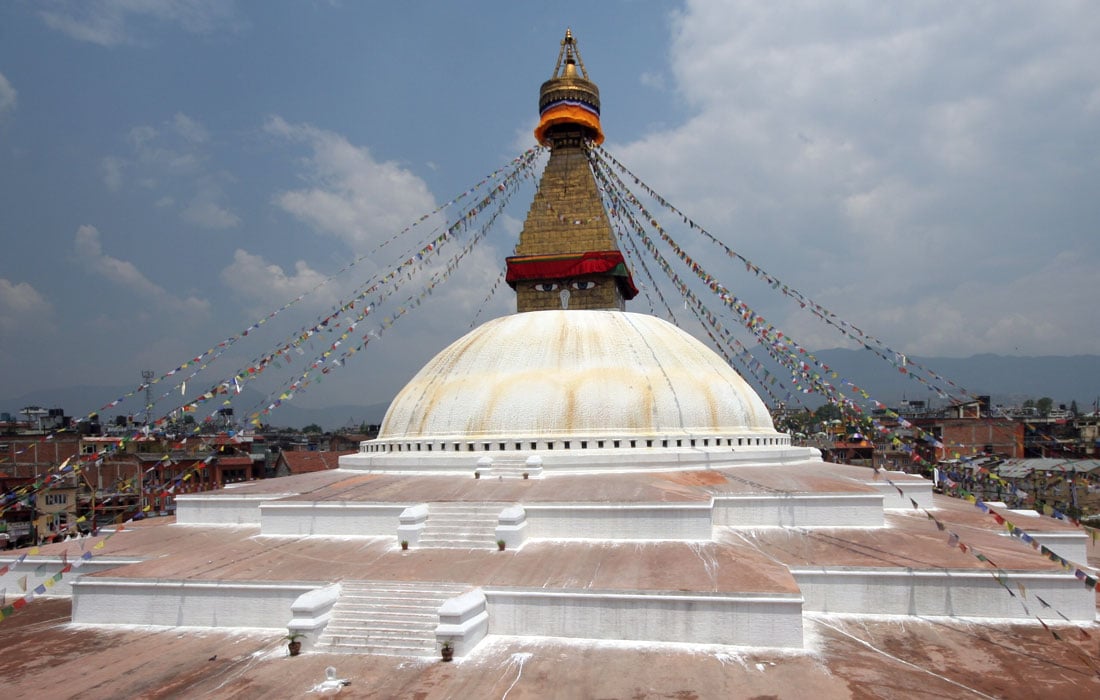

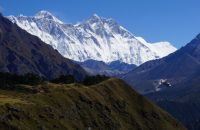
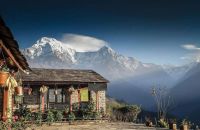
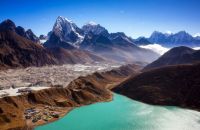
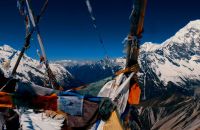
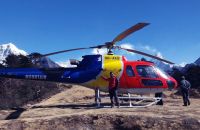





.jpegXkO.jpeg&width=200&height=130)










Recent Comments